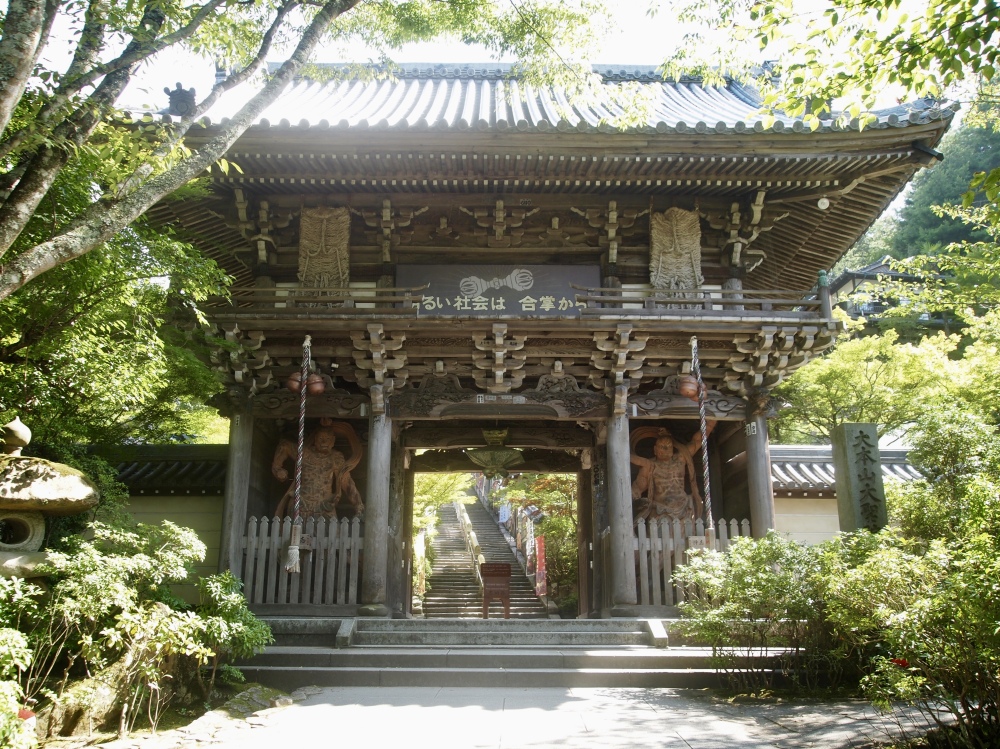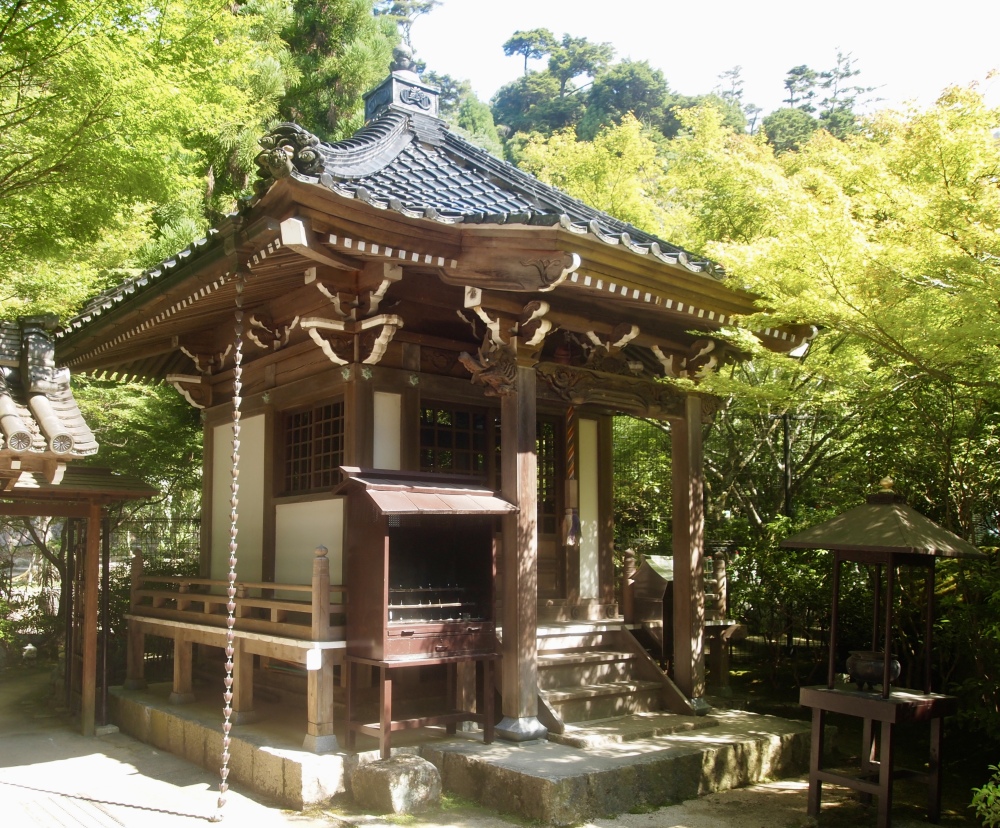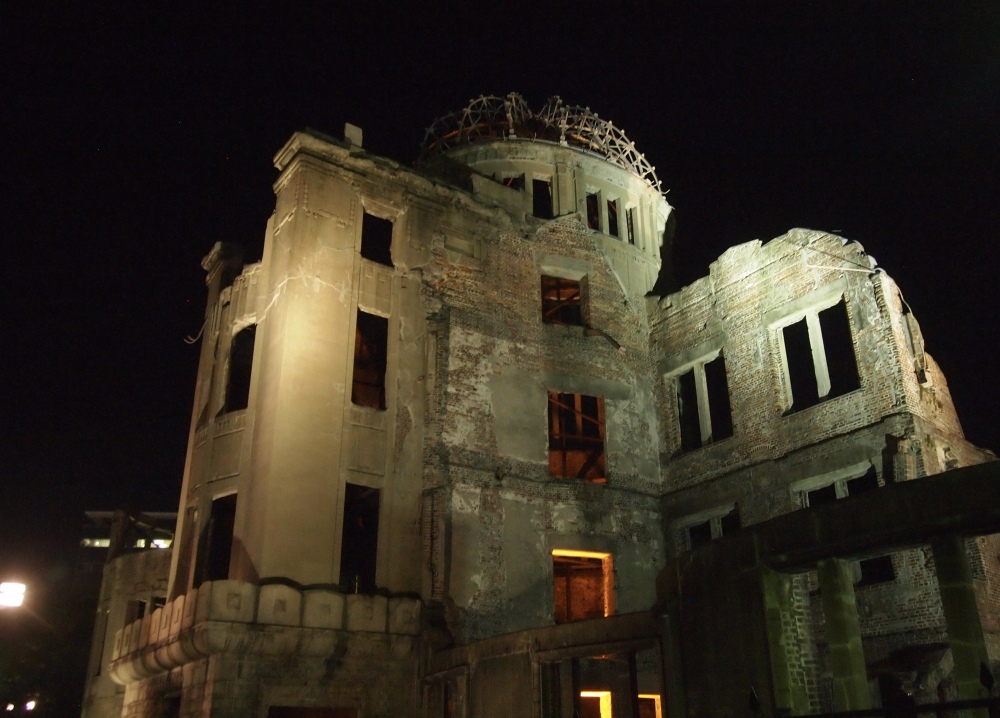Archive for the ‘500 Statues of Rakan’ Category
Wednesday, August 2: After visiting the O-torii Gate at Itsukushima Shinto Shrine at somewhat low tide, I take a break to walk uphill toward Daishō-in, a historic Japanese temple complex on Mount Misen, the holy mountain on Miyajima. Including Mt. Misen, Daishō-in is within the World Heritage area of Itsukushima Shrine.
Mt. Misen sits in the middle of Miyajima Island. The mountain was opened as an ascetic holy mountain site by Kobo Daishi in the autumn of 806 when he underwent ascetic practice for 100 days in the mountain. The fire lit by Kobo Daishi is said to have been burning for 1200 years. The fire was used to light the Flame of Peace in the Hiroshima Peace Memorial Park.
Daishō-in Temple is one of the most prestigious Shingon Temples in the western part of Japan. The Shingon, or “True Word,” branch of esoteric Buddhism, was introduced to Japan from China in the 9th century. Shingon involves trying to reach the eternal wisdom of the Buddha that wasn’t expressed in his public teaching. The sect believes that this wisdom may be realized through rituals using body, speech, and mind, such as the use of symbolic gestures (mudras), mystical syllables (dharani), and mental concentration (yoga). The whole is intended to arouse a sense of the pervading spiritual presence of the Buddha that resides in all living things, according to Encyclopedia Britannica: Shingon.
In the 12th century, Emperor Toba founded his prayer hall in Daishō-in. The temple had close links with the Imperial Family until the 19th century. Emperor Meiji stayed in the temple in 1885 (Welcome to Miyajima: Daishō-in).
Though I love the bright vermilion of many Japanese temples, I have a fondness for the wooden structures that look ancient and weathered and seem to blend in with nature.
The Niomon Gate serves as the official gateway into the temple. A pair of guardian king statues stand by the gate. Nio kings are believed to ward off evil, and are determined to preserve Buddhist philosophy on earth.

Niomon Gate of Daishō-in
Kukai, posthumously known as Kobo Daishi, is the founder of the Shingon sect. In 804, at age 31, he went to Tang, China, where he mastered profound esoteric teachings. He is also well-known as one of the three greatest calligraphers in Japan.

Niomon Gate

lantern at Daishō-in
Lining the steps to the temple are the statues of 500 Rakan statues. These represent Shaka Nyorai’s disciples. These images all have unique facial expressions. Besides the Rakan statues listed on the map below, there are other statues spread sporadically throughout the temple complex.

map of Rakan statues at Daishō-in

Rakan statues at Daishō-in

Rakan statues at Daishō-in

Rakan statues at Daishō-in

Rakan statues at Daishō-in

Rakan statues at Daishō-in

Rakan statues at Daishō-in

Rakan statues at Daishō-in

Rakan statues at Daishō-in

Rakan statues at Daishō-in

Rakan statues at Daishō-in

Rakan statues at Daishō-in

Rakan statues at Daishō-in

Rakan statues at Daishō-in

Rakan statues at Daishō-in

Rakan statues at Daishō-in
There are so many interesting things to see at this temple complex, even if I don’t know what many of them are.

water pavilion at Daishō-in

Daishō-in

Shimo Daishi-do Hall at Daishō-in
Along the temple steps is a row of spinning metal wheels that are inscribed with sutra (Buddhist scriptures). Turning the inscriptions as one walks up is believed to have the same effect as reading them. So, without any knowledge of Japanese, a visitor can be blessed with enormous fortune by turning the wheels (japan-guide.com: Daishō-in).

stairs and prayer wheels
The bell in the belfry was once rung to tell the time in the morning, afternoon and evening in the past. Now it is rung to start the time for worship.

Belfry
Kannon-do Hall was established to enshrine the image of Kannon Bosatsu, the Deity of Mercy.

Kannon-do Hall

Kannon-do Hall

ceiling at Kannon-do Hall

treasures in Kannon-do Hall

treasures in Kannon-do Hall
A mandala using colored sand depicts the divine figure of Kannon Bosatsu, the symbol of mercy. The mandala was made by Buddhist priests from Tibet.

Kannon-do Hall
Bosatsu, or Bodhisattvas, are the ones who are undergoing ascetic training to attain enlightenment; they are committed to NOT becoming Nyorai (the highest deities of Buddhism who have attained enlightenment) unless all sufferers on earth are saved. To show their determination, Bosatsu images hold various objects.

Kannon-do Hall

ship at Kannon-do Hall

character at Daishō-in

figure at Daishō-in

figure at Daishō-in

figure at Daishō-in

figure at Daishō-in

figure at Daishō-in

ema at Daishō-in

ema at Daishō-in

ema at Daishō-in

figure at Daishō-in

figure at Daishō-in
Maniden Hall is the main prayer hall where Sanki Daigongen, or the Three Awesome Deities of Mt. Misen, are enshrined.

steps to Maniden Hall

Maniden Hall

object at Maniden Hall

Maniden Hall

Maniden Hall

Maniden Hall
Worshipers pray at Maniden Hall for good health, longevity, and contentment in their daily lives.

Maniden Hall

figures at Daishō-in

Daishō-in
Commemorating the current (77th) head priest’s succession, 1,000 Fudo myo-o, or Immovable King, images were donated by worshipers.

one thousand Fudo myo-o, or Immovable King, images

figures at Daishō-in
In the dimly lit Henjokutsu Cave are the sand and the principal Buddhist icons of the 88 temples of the prestigious pilgrimage route on Shikoku. Worshipers believe that they are given the same blessings as people who make the pilgrimage to all the temples on the route (Welcome to Miyajima: Daishō-in).
It is my dream to one day do the Pilgrimage to the 88 Sacred Places of Shikoku.

representations of 88 temples of Shikoku in Henjokutsu Cave

pond at Daishō-in

figure at Daishō-in
After leaving Daishō-in, I visit Itsukushima Shinto Shrine and the O-torii Gate once again, as I make my way back to the ferry. This time the tide is higher (miyajima: itsukushima-jinja & the floating o-torii gate). Then I return by ferry and train to Hiroshima. At my hotel, I ask for a recommendation for a good okonomiyaki restaurant. Hiroshima is famous for oysters and okonomiyaki (savory pancakes: batter, cabbage, vegetables and seafood or meat cooked on a griddle). The local version, Hiroshima-yaki, features individual layers, and noodles as the key ingredient (Lonely Planet Japan).
The place recommended by the hotel is open air with no air-conditioning. It is much too hot for me to eat in there. I’ve been sweating all day and look forward to cooling off during dinner. So I walk back up the same street and find the perfect (air-conditioned) restaurant.

diner for Hiroshima-yaki
Here I’m greeted by a very friendly waitress who speaks some English. A baseball game is on the TV in the background, and she keeps cheering for the Hiroshima Toyo Carp, the local baseball team.

diner for Hiroshima-yaki
It’s quite a process watching the chef whip up the Hiroshima-yaki. I’m able to order mine with just shrimp. I never want squid in these pancakes, even though squid seems to be the most common ingredient.
I have to say this pancake is one of the most delectable things I’ve eaten in Japan. Even though it’s huge, and filling, I have to eat every last bite. 🙂

cooking Hiroshima-yaki

Hiroshima-yaki

Hiroshima-yaki

baseball at the local diner

Hiroshima-yaki

Hiroshima-yaki

Hiroshima-yaki
After dinner, I stroll along the river in Hiroshima.

a pretty restaurant along the river

twinkling lights

riverside restaurant
I see one last view of the Hiroshima A-bomb dome.

Hiroshima A-bomb dome

Hiroshima A-bomb dome

paper cranes for peace
Tomorrow morning, I’ll leave for Nara, where I’ll spend two nights. 🙂
Total steps today: 21,442 (9.09 miles)
Saturday, July 8: After leaving the Kawagoe City Museum, I stop briefly at the Honmaru Goten (primary hall) of Kawagoe Castle. It’s not open to the public, so there isn’t much to see except the facade. As Kawagoe was considered by the Tokugawa Shogunate to be an important place for protecting the northern region, the Shogun dispatched his trusted chief vassal to Kawagoe Castle for greater protection. Only the primary hall remains to this day.

Honmaru Goten of Kawagoe Castle
I continue to walk quite a distance through the baking streets until I reach Naritasan Kawagoe Betsuin Temple. There’s not much to see here except an angry-looking fellow, so I surreptitiously walk past to Kita-in Temple.

Naritasan Kawagoe Betsuin Temple

stone lanterns at Naritasan Kawagoe Betsuin Temple
Founded as Muryoju Temple by the monk Ennin during the Heian period (794 to 1185), Kita-in Temple has ties to the Tokugawa Shogunate. Muryoju is another name for the Amitabha Buddha (Buddha of Unending Life), which is the main object of worship at the temple.
Burned down during fighting in 1205, the temple was rebuilt in 1298 by the monk Sonkai. Emperor Gofushimi made it head of the Tendai Sect temple in east Japan in 1300.

Kita-in pagoda
Kita-in became the main temple of the three-temple complex after Tenkai became the head monk in 1599. Previously, Nakain Temple had been the most influential. Under Tenkai’s influence and his friendship with the first Tokugawa shogun, Ieyasu, Kita-in flourished. The Chinese characters used to write Kita-in were changed from those meaning North Temple, which has a dark image, to those meaning Temple of Much Happiness.

Main Hall at Kita-in

Main Hall at Kita-in

inside the Main Hall at Kita-in

small shrine at Kita-in

Small building on the temple grounds

ema at Kita-in

ema at Kita-in

ema at Kita-in

ema at Kita-in
On January 3, the first Darumaichi (Good Luck Market) of the year is held along with Buddhist fire rites to pray for good luck, protection from misfortune, family safety and traffic safety.

Main Hall at Kita-in

pagoda at Kita-in

pagoda at Kita-in

pagoda at Kita-in

pagoda at Kita-in

small shrine at Kita-in
To help rebuild Kita-in, Shogun Iemitsu ordered several buildings to be moved from Edo Castle (now the site of the Imperial Palace in Tokyo) to Kawagoe. These buildings, which house Kita-in’s museum, today are protected as Important Cultural Properties. They are all that remain of the buildings of Edo Castle because of the damage Tokyo suffered during the Great Earthquake of 1923 and World War II.

inside the remains of Edo Castle

a chest in the Edo Castle remains

inside looking out – Edo Castle Remains
Kita-in has several gardens both inside and outside the museum area. Planted with plum, cherry, and maple trees, plus a variety of flowers, particularly hydrangeas and azaleas, the gardens change throughout the year.

garden at Edo Castle remains

garden at Edo Castle remains

Edo Castle remains

Edo Castle remains

Edo Castle remains

painted door in Edo Castle remains

Festival cart

Edo Castle remains

walkway at Edo Castle remains
The famous statues known as the “500 Statues of Rakan” actually consist of 540 statues representing the disciples of Buddha. They were carved between 1782 and 1825 with no two statues alike. It is said that if you feel among the statues in the dead of night, you will find one that is warm. Mark it, come back during the day, and you will see it is the statue most resembling yourself.
The English-speaking ticket-taker at the 500 Statues of Rakan asks for my birth year. He tells me I was born in the Year of the Sheep. Sometimes it’s also called the year of the Goat or the Ram. The kind man tells me I should look for the Rakan holding a sheep, and when I find it, I should rub it for good luck.

500 Statues of Rakan

500 Statues of Rakan

500 Statues of Rakan

500 Statues of Rakan

500 Statues of Rakan

500 Statues of Rakan

500 Statues of Rakan

500 Statues of Rakan

500 Statues of Rakan

500 Statues of Rakan

500 Statues of Rakan
I spend quite some time looking for the Rakan with the sheep, but, when I can’t find it, I ask the ticket-taker to show me where it is. He takes me right to it. I do as he suggested and rub the head for good luck! He looks like a jolly fellow. 🙂

Rakan with sheep

Temple in the Kurazukuri Zone

Temple in the Kurazukuri Zone

Temple in the Kurazukuri Zone

ema at the temple

ema at the temple

ema at the temple

wishes (?) at the temple
I don’t stay long at the temple, because I want to return to one of the shops for some pretty ceramic cups I had seen earlier. Even if I don’t buy anything, I’d love to dip into the shop for a blast of cool air. I continue down the street until I find the shop, passing some deer street art on the way.

street art in Kawagoe
I find the shop, where I linger and cool off for a bit, and then I buy two pretty cups. The shopkeeper wraps them carefully in bubble wrap. I intend at this point to still look for the bell tower, but after asking the shopkeeper about the bus back to the station, she walks out to the sidewalk with me, pointing out the bus stop. I see the bus is just pulling up to the stop. At the spur of the moment, I decide I’ll run for the bus and jump on. I’m too hot and exhausted to walk around Kawagoe any more. Oh, how I hate the summer heat!
It’s about 10 minutes to the train station, and another 1 1/2 hours to get back to Fuchinobe, but I’m relieved to be sitting on the cool train for a good long while. When I get home, I stop at Chiyoda sushi and buy some take-out sushi. I don’t want to eat anything hot tonight, so sushi will be the perfect refreshing end to the day.
Later, when I write to my Instagram friend Yukie about my HOT day in Kawagoe, she says, “Omg Cathy… Kawagoe is famous for its hot weather during the summer! It’s one of the places where the temperature goes the highest in Japan sometimes…”
I write her back, “Oh gosh! I wish I had known. I almost felt like I was going to faint at times. I had to keep stopping into shops for the AC and drinking lots of water!”
At the same time I send her these messages, I also send her my wish list of all the places I still want to see before I leave Japan and ask if she’d like to join me for an outing. She suggests we meet on Sunday, July 16 to see an exhibit by Yoshida Hiroshi at the Sampo Japan Nipponkoa Museum of Art. I tell her I may also want to see Kabukicho, so she’d be welcome to come along if she’d like. I’m so excited to finally be able to meet her!
Total steps today: 17,143 (7.26 miles).
Most of the information about Kita-in Temple is from a pamphlet prepared by the Kawagoe-Salem Friendship Society, a grassroots group formed in 1986 to promote international understanding and goodwill especially between the two sister cities Kawagoe and Salem, Oregon, USA.



























































































































